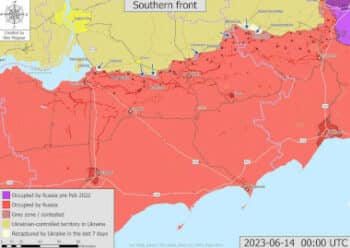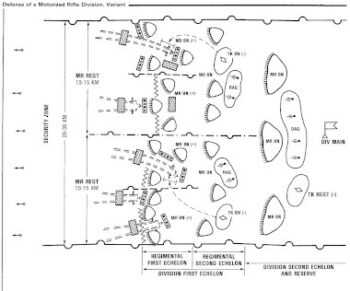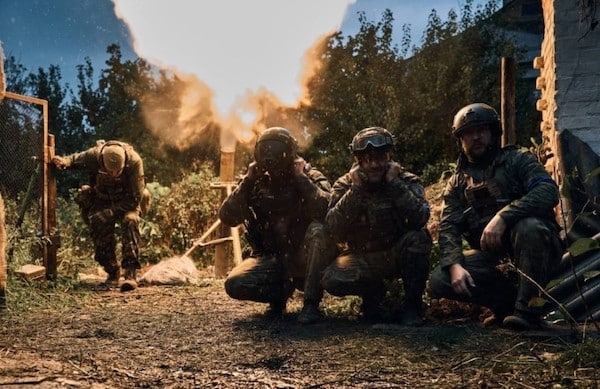On June 4/5 the Ukrainian military launched its long announced counteroffensive in southeast Ukraine. Ten days later there is no significant progress.
 This is not the outcome the war propagandists expected:
This is not the outcome the war propagandists expected:
[General Petreus] spoke about the situation in Ukraine to BBC Radio 4’s Today programme.On the counteroffensive, he said:I think that this counteroffensive is going to be very impressive.
My sense is that they will achieve combined arms effects in other words, they will successfully carry out combined arms operations where you have engineers that are breaching the obstacles and diffusing the minefields and so forth; armour following right on through protected by infantry against anti-tank missiles; air defence keeping the Russians aircraft off them; electronic warfare jamming their radio networks; logistics right up behind them; artillery and mortars right out in front of them.
And most important of all … is that as the lead elements inevitably culminate after 72-96 hours, physically that’s about as far as you can go, and they’ll have taken losses … you have follow-on units that will push right on through and capitalise on the progress and maintain the momentum and I think that can get the entire Russian defence in that area moving, then I think you have other opportunities that will open up on the flanks as well.
Back in reality the lead elements of the Ukrainian attack got slaughtered. They ‘culminated’, i.e. lost their ability for further attacks, in less than a day:
The men of Ukraine’s 37th Brigade were freshly trained and armed with Western-supplied weapons, tasked with an initial push through Russian-occupied territory in the early days of a long-awaited counteroffensive.They would pay a heavy price.
Within 20 minutes of their June 5 advance south of Velyka Novosilka, in the southeast Donetsk region, mortars exploded all around them, soldiers said. A 30-year-old soldier known as Lumberjack saw two of the men in his vehicle bleeding heavily; one lost an arm as he cried out for his family. Lumberjack crawled into a crater, but the shrapnel from a mortar went through the soil and pierced his shoulder.
“We were left there in the field, without tanks or heavy armor,” said Lumberjack, who spoke to The Washington Post on the condition that he be identified only by his call sign because he was not authorized to discuss the battle. “We were shelled with mortars from three sides. We couldn’t do anything.”
There were fewer than 50 men in the unit, he said, and 30 did not return–they were killed, wounded or captured by the enemy. Five of the unit’s armored vehicles were destroyed within the first hour.
Whoever trained those units made grave mistakes:
For the first hour and a half of the 37th’s assault near Velyka Novosilka, the Russians bombarded the unit with nonstop shelling that penetrated their AMX-10 RC armored vehicles, according to Grey, another soldier in the battalion who spoke on the condition that he be identified only by his call sign. The armored vehicles, sometimes called “light tanks,” were not heavy enough to protect the soldiers, Grey said, and had to be positioned behind them instead of in front.
The AMX-10 isn’t a tank and can not be used as one. It is a wheeled light reconnaissance vehicle built by France 50 years ago to dominate insurgents in its former African colonies. One of its main features is to have a good speed when in reverse gear. This to bail out as soon as serious counter forces are detected.
The Ukrainian counterattack is now stuck in the Russian defense security zone, miles away from the real defense lines. This was predictable.
As the U.S. Field Manual 100-2-1 described the Soviet army in defense (pg 93ff):
When the defense is established before contact with the enemy, the Soviets establish a security echelon up to 15 kilometers forward of the main defensive area. The elements which make up the security echelon come from the division’s second echelon. A security force of up to battalion size may be deployed in front of each first echelon regiment.A detailed and coordinated fire plan is developed. Weapons are positioned so that the maximum amount of fire can be brought to bear directly in front of the [Forward Edge of the Battle Area]. Enemy penetrations are blunted by shifting artillery fire and by conducting counterattacks.
 The Ukrainian army used at least four brigades for its attack. At least two of those were from the 12 brigade reserve that had been built up for the counterattack. With losses of some 30% those involved were seriously mauled for little to no gain:
The Ukrainian army used at least four brigades for its attack. At least two of those were from the 12 brigade reserve that had been built up for the counterattack. With losses of some 30% those involved were seriously mauled for little to no gain:
The Russians are trying to inflict as many casualties and destroy as many vehicles as possible in a battle zone ahead of the main defensive line, depleting Ukrainian forces before they reach it. In effect, it turns the area in front of the main defense line into a kill zone.
…
If the Russian strategy proves effective, Ukraine could lose too many of its newly trained troops–which number in the tens of thousands–and too many tanks and infantry fighting vehicles to breach the main line.Even if they get that far, the forces might be too weakened to stream south and help accomplish a major objective: severing the so-called land bridge that connects Russia to the occupied Crimean Peninsula. This would be done by reaching the Sea of Azov, about 60 miles away.
The Ukrainian forces were obviously not trained for this. They also attacked in too many places. The map at the top shows attack arrows in 7 places and four main directions. One or two attack directions, with more concentrated forces, might have created better results.
The Russian President Putin recently described the Ukrainian casualties:
I will not give the number of personnel losses. I will let the Defence Ministry do it after it runs the numbers, but the structure of losses is unfavourable for them as well. What I mean to say is that of all personnel losses—and they are approaching a number that can be called catastrophic—the structure of these losses is unfavourable for them. Because as we know, losses can be sanitary or irretrievable. Usually, I am afraid I may be off a little, but irretrievable losses are around 25 percent, maximum 30 percent while their losses are almost 50/50. This is my first point.Second, if we look at irretrievable losses, clearly, the defending side suffers fewer losses, but this ratio of 1 to 10 is in our favour. Our losses are one-tenth of the losses of the Ukrainian forces.
Since the start of the counterattack the Russian daily report has listed a total of some 10,500 Ukrainian casualties.
A second large attempt to cross the Forward Edge of the Battle Area (FEBA) with the remaining Ukrainian forces is expected, but is unlikely to have a better outcome. The long promoted Ukrainian counterattack is likely to end with high Ukrainian losses and no gains.
This then will soon become a huge political problem:
As he heads into next year’s reelection campaign, Biden needs a major battlefield victory to show that his unqualified support for Ukraine has burnished U.S. global leadership, reinvigorated a strong foreign policy with bipartisan support and demonstrated the prudent use of American military strength abroad.
…
A muddled outcome of limited gains in Ukraine would provide grist for all of those critiques and further cloud the already murky waters of NATO and European Union debate over future posture toward both Ukraine and Russia. A less than “overwhelming” success would probably also increase pressure in the West to push Kyiv to negotiate a territorial settlement that may not be to its liking.
There is little the Biden administration can do to change the grim picture. Congress will likely prevent it from openly using the U.S. military in Ukraine. The European NATO allies have now seen what the Russian army can do to its enemies. They will not be eager to see the same done to their own troops.
That leaves negotiations as the only way out.
The question for Russia is when and with whom. Talks with only Ukraine, a mere U.S. proxy with no real say, would be insufficient. It is the U.S. government that must agree to a new security architecture in Europe. The Russian conditions for peace will be harsh and it will still take a lot of time, and many dead Ukrainians, until the U.S. agrees to them.

